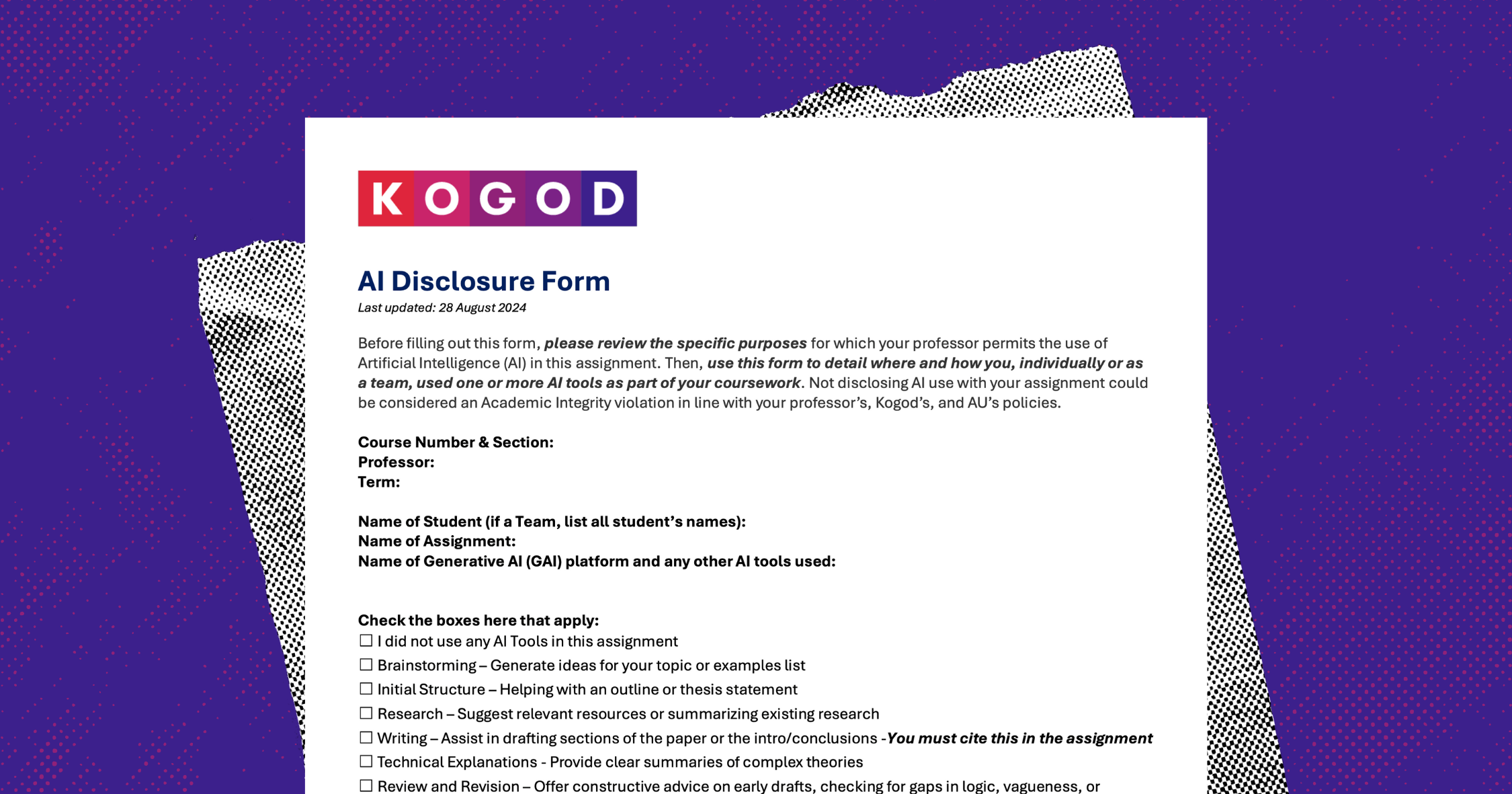
Angela Virtu
Assistant Director, Institute for Applied AI Professorial Lecturer, IT and Analytics AI Instructional Faculty Fellow
The State of Play: AI in the Classroom
Artificial intelligence (AI) is deeply embedded across organizations of every stripe, and its adoption is growing at a faster clip than reports can be published. According to McKinsey’s “The State of AI” Report, the number of companies using AI in at least two functional areas doubled from 31% to 63% in 2024, signaling the scale and the speed of this transformation. In addition to changing how businesses operate, this large-scale adoption of AI has changed what employers expect from recent graduates and new hires. But employers aren’t the only ones changing their expectations and their behaviors.
At colleges across the country, administrative concerns around academic integrity and the decline of critical thinking persist—but nearly half of students in the Digital Education Council’s 2024 Global AI Student Survey say they need clearer guidance from faculty on when and how AI can be used.
One Business School’s Solution to AI Tensions: The AI Disclosure Form
At the Kogod School of Business, where I’m a professor and the associate director of the Institute for Applied Artificial Intelligence (IAAI), we chose a different path—one that’s grounded in radical transparency and that empowers both students and faculty to navigate AI use openly and ethically.
To instill students with the right mentality around how to use AI—and to track their usage in the classroom in a flexible, collaborative way—Kogod introduced a schoolwide AI Disclosure Form: a practical, easy-to-adopt tool that transforms AI in the classroom from something taboo into an integral aspect of the learning process.
At Kogod, the AI Disclosure form is introduced at the beginning of an assignment to provide a structured framework between faculty and students about responsible AI use. The disclosure form also documents how and when AI tools are used throughout that assignment.
Kogod’s AI Disclosure Form comprises three parts: Categorizing AI Use, Disclosure of AI Conversations, and Reflection.
Categorizing AI Use
Faculty provide a list of acceptable AI usage for an assignment to help students identify how AI can support them.
Students reflect on how they used AI throughout the assignment and mark the boxes to ensure transparency in their AI usage.
Disclosure of AI Conversations
Students share AI prompts used for each assignment, allowing faculty to understand not only what was produced but how students collaborated with AI during their learning.
Reflection
Students consider how AI shaped their work throughout their assignments, promoting higher accountability for students to use AI as a tool to enhance their learning.
Adopting the AI Disclosure Form on assignments provides faculty insight into how students are using AI to work on their deliverables. This helps faculty clearly distinguish between student work and AI-generated contributions, enabling accurate assessment and targeted feedback. It also encourages open, thoughtful conversations about how and why AI can be used to solve real-world problems based on the assignment’s learning objectives.
How Faculty Can Implement an AI Disclosure Form
Merely introducing an AI Disclosure Form is not enough to fully support student learning. Like most tools in learning environments, the AI Disclosure Form only succeeds when trust, clarity, and open communication are established from the outset and maintained throughout the process. To support this type of set-up, we recommend the following tips for faculty looking to implement an AI Disclosure Form on their assignments:
Align with Pedagogical Goals for Complex Assignments
Faculty should prioritize integrating the AI disclosure form into large or multi-step assignments—such as research papers, case studies, or cumulative projects—where it is most difficult to discern the difference between AI-assisted and student-generated work. This approach should reflect the instructor’s underlying teaching philosophy and intended learning outcomes, ensuring that AI usage tracking reinforces core course objectives rather than replacing key learning opportunities. This encourages students to view the disclosure form as part of the assignments as opposed to an administrative burden tacked on to the smallest of activities.
Initiate Dialogue
At the start of each assignment, faculty should complement the disclosure form with a guided conversation to clearly explain all expectations of AI use on the assignment and encourage responsible use of all AI tools. In the conversation, the instructor should outline permitted AI uses, boundaries and restrictions, and concrete examples to set expectations and further strengthen the students’ understanding of the process. Consider using an example with your own experiences using AI in academic or professional work; this openness helps students understand expectations, reduces stigma, and models transparency from the top.
Encourage Ongoing Usage of the Form
Check in before the assignment due date to remind students to take notes as they work through the assignment. Have them record how and when AI tools are employed to foster self-awareness and thoughtful use.
Review and Evaluate Students’ Submissions
After students submit the completed disclosure form alongside their assignment, instructors can review students’ forms to gain insights into both the thought process behind their AI usage and the way AI was used to shape the final product.
This transparent workflow both strengthens academic integrity and helps students develop habits for responsible AI use in their future careers.
Bonus Tip: For ease and consistency, integrate the AI Disclosure Form directly into your LMS as a quiz or form-fill. This streamlines the process, reduces administrative burden, and minimizes confusion about assignment submissions.
How Institutions Can Implement an AI Disclosure Form at Scale
Engage Faculty Early and Often
Kogod’s AI Disclosure form was developed in collaboration with Kogod’s Center for Professionalism and Communications and a subset of Undergraduate Core Course Coordinators. Developing the form as a joint effort ensures the approach is both pedagogically sound and aligned with larger curriculum objectives.
Embed Consistent, Institution-Wide Use
Trying to institute a form for one-off use—or worse, with varying standards from class to class or department to department— doesn't provide students with the comprehensive understanding of AI that will be expected of them after graduation. By setting an institution-wide expectation for standard use of the form across multiple assignments and multiple courses, students begin viewing it as a regular tool rather than an administrative checkbox. This regular exposure and engagement with the AI Disclosure Form leads to lasting habits of responsible AI use even after a course is over.
Conclusion
Embracing AI in the classroom through the AI Disclosure Form has allowed the Kogod School of Business to set a new standard for ethical innovation in higher education. By making AI use visible and reflective, Kogod promotes deeper learning and more critical thinking among our students. Institutions ready to build a culture of radical transparency can adapt this approach to navigate through the AI era with intention.
This article was written by Professor Angela Virtu, edited by AI for clarity and concision, and reviewed before publication.
